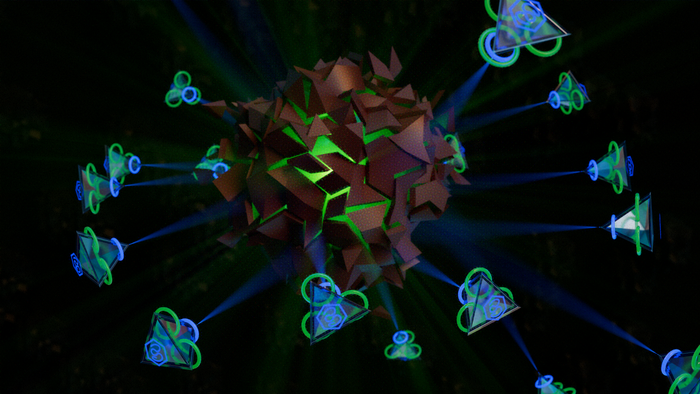The immune system has evolved to safeguard the body from a wildly diverse range of potential threats. Among these are bacterial diseases, including plague, cholera, diphtheria and Lyme disease, and viral contagions such as influenza, Ebola virus and SARS CoV-2.

Credit: Graphic by Jason Drees
The immune system has evolved to safeguard the body from a wildly diverse range of potential threats. Among these are bacterial diseases, including plague, cholera, diphtheria and Lyme disease, and viral contagions such as influenza, Ebola virus and SARS CoV-2.
Despite the impressive power of the immune system’s complex defense network, one type of threat is especially challenging to combat. This arises when the body’s own native cells turn rogue, leading to the phenomenon of cancer. Although the immune system often engages to try to rid the body of malignant cells, its efforts are frequently thwarted as the disease progresses unchecked.The illustration shows a cancer cell (center) surrounded by immune T-cells augmented with an oncolytic (cancer-fighting) virus. A new study describes how a combination of immunotherapy and virotherapy, using myxoma virus, provides new hope for patients with treatment resistant cancers.
In new research appearing in the journal Cancer Cell, corresponding authors Grant McFadden, Masmudur Rahman and their colleagues propose a new line of attack that shows promise for treatment-resistant cancers.
The approach involves a combination of two methods that have each shown considerable success against some cancers. The study describes how oncolytic virotherapy, a technique using cancer-fighting viruses, can act in concert with existing immunotherapy techniques, boosting the immune capacity to effectively target and destroy cancer cells.
Oncolytic viruses represent an exciting new avenue of cancer therapy. Such viruses have the remarkable ability to hunt and terminate cancer cells while leaving healthy cells unharmed, as well as enhancing the immune system’s ability to recognize and terminate cancer cells.
One such virus, known as myxoma, is the focus of the current research and an area of expertise for the research group. The study shows that the use of T-cells infected with myxoma virus can induce a form of cancer cell death not previously observed.
Known as autosis, this form of cell destruction may be particularly useful against solid tumors that have proven treatment-resistant to various forms of cancer therapy, including immunotherapy alone.
“This work affirms the enormous potential of combining virotherapy with cell therapy to treat currently intractable cancers,” McFadden says.
McFadden directs the Biodesign Center for Immunotherapy, Vaccines and Virotherapy at Arizona State University.
Internal sentries
The immune system is composed of a range of specialized cells designed to patrol the body and respond to threats. The system is involved in a ceaseless arms race against pathogens, which evolve sophisticated techniques to attempt to outwit immune defenses, propagate in the body and cause disease. Cancer presents a unique challenge to the immune system as tumor cells often lack the identifying cell features that allow the immune system to attack them by distinguishing self from non-self.
Cancer cells can further short-circuit immune efforts to hunt and destroy them, through a range of evasive strategies. Researchers hope to help the immune system to overcome cancer’s notorious tactics of disguise, developing new experimental techniques belonging to a category known as adoptive cell therapy, or ACT.
Such methods often involve removing a collection of cancer-fighting white blood cells known as T-cells, modifying their seek-and-destroy capacities and reinjecting them in patients. Two forms of ACT immunotherapy are described in the new study: CAR T-cell therapy (CART) and T Cell Receptor Engineering (TCR). The basic idea in each case is the same: treating cancer with activated T lymphocytes extracted from the patient.
New method delivers one-two punch to tumor cells
The development of these therapies has been nothing short of revolutionary, and some cancer patients facing grim prospects have made remarkable recoveries following the use of immunotherapy. But techniques like CART and TCR nevertheless have their limitations and are often ineffective against advanced solid tumors. In such cases, cancer cells often manage to evade destruction by T-cells by downregulating or losing the surface antigens or MHC proteins that T-cells use to identify them.
The new study highlights the ability of immunotherapy when it is coupled with virotherapy to break through the wall of cancer resistance, specifically using myxoma-equipped T-cells. The myxoma can target and kill cancer cells directly but more usefully can induce an unusual form of T-cell directed cell death known as autosis. This form of cell death augments two other forms of programmed cancer cell death induced by T-cells, known as apoptosis and pyroptosis.
During myxoma-mediated autosis, cancerous cells in the vicinity of those targeted by the therapy are also destroyed in a process known as bystander killing. This effect can considerably enhance the dual therapy’s aggressive eradication of cancer cells, even in notoriously hard-to-treat solid tumors.
A combined myxoma-immunotherapy approach therefore holds the potential to turn so-called “cold tumors,” which fly under the immune system’s radar, into “hot tumors” that immune cells can identify and destroy, allowing CAR T-cells or TCR cells to enter the tumor environment, proliferate and activate.
“We are at the edge of discovering newer aspects of the myxoma virus and oncolytic virotherapy,” Rahman says. “In addition, these findings open the door for testing cancer-killing viruses with other cell-based cancer immunotherapies that can be used in cancer patients.”
The ability to radically reengineer oncolytic viruses like myxoma to target a range of resistant cancers provides a new frontier for the treatment of this devastating disease.
Journal
Cancer Cell
DOI
10.1016/j.ccell.2022.08.001
Method of Research
Experimental study
Article Title
Induction of tumor cell autosis by myxoma virus-infected CAR-T and TCR-T cells to overcome primary and acquired resistance
Article Publication Date
25-Aug-2022




